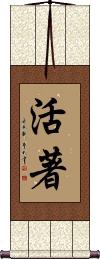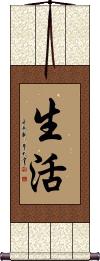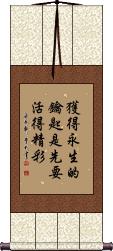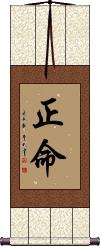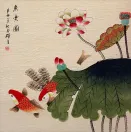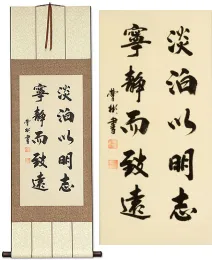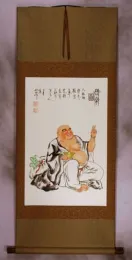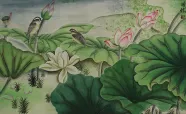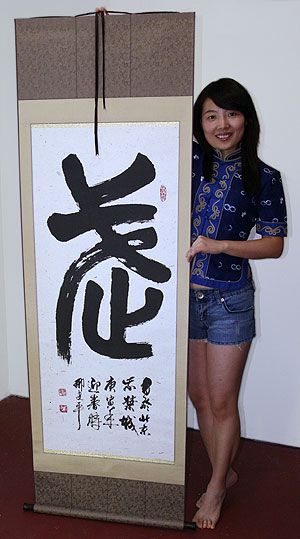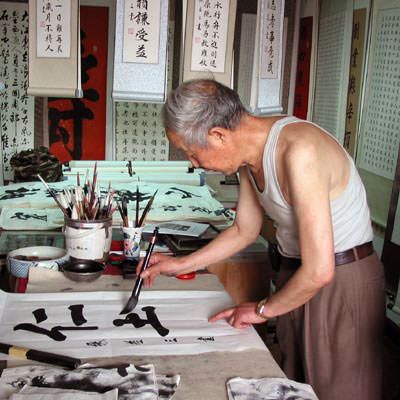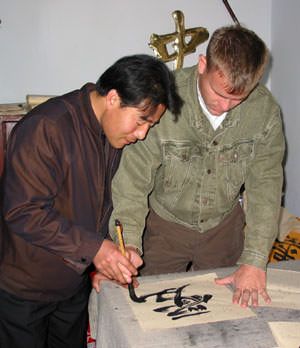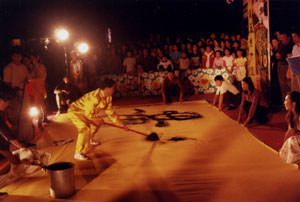Many custom options...
And formats...

Right Living in Chinese / Japanese...
Buy a Right Living calligraphy wall scroll here!
Personalize your custom “Right Living” project by clicking the button next to your favorite “Right Living” title below...
1. Alive
4. The key to immortality is first living a life worth remembering
Alive
Healthy Living
If you are into healthy living, 健康生活 might be an excellent selection for a wall scroll to hang in your home.
The first two characters speak of health, vitality, vigor, and being of sound body. The second two characters mean living or life (daily existence).
Living / Live Life
生活 means life, living, to live, or the state of being alive. It can also refer to your daily existence or livelihood. It can also be a suggestion to just “Live life.”
生活 is also the term used in other titles such as “healthy living” or Lance Armstrong's “Livestrong” campaign (Chinese title for Livestrong only).
If you need a reminder that you are alive and to take a breath, this might be the perfect wall scroll for you.
The key to immortality is first living a life worth remembering
Embrace Life / Embrace Living
5. Right Living / Right Livelihood / Perfect Livelihood
Samyag Ajiva / Samma Ajiva
正命 (right living) is one of the Noble Eightfold Paths of Buddhism.
Right Living, along with Right Speech and Right Action, constitute the path to Virtue.
Right Living means that a Buddhist should only take a job or pursue a career in a field that does no harm. Buddhists should not work in the arms trade, as pimps or in the field of prostitution, as a butcher or in a shop that kills or sells meat, in a laboratory that does animal research, or in any other business that involves scheming or unethical behavior.
Another definition: Avoidance of professions that are harmful to sentient beings, such as slaughterer, hunter, dealer in weaponry or narcotics, etc.
This term is exclusively used by devout Buddhists. It is not a common term, and is remains an unknown concept to most Japanese and Chinese people.
See Also: Buddhism | Enlightenment | Noble Eightfold Path
This in-stock artwork might be what you are looking for, and ships right away...
Gallery Price: $101.00
Your Price: $55.88
Gallery Price: $101.00
Your Price: $55.88
Gallery Price: $500.00
Your Price: $178.88
Gallery Price: $300.00
Your Price: $195.88
Gallery Price: $198.00
Your Price: $109.88
Not the results for right living that you were looking for?
Below are some entries from our dictionary that may match your right living search...
| Characters If shown, 2nd row is Simp. Chinese |
Pronunciation Romanization |
Simple Dictionary Definition |
心 see styles |
xīn xin1 hsin shin しん |
More info & calligraphy: Heart / Mind / Spirit(1) (See 心・こころ・1) heart; mind; spirit; vitality; inner strength; (2) bottom of one's heart; core (of one's character); nature; (3) (usu. written as 芯) (See 芯・2) centre; center; core; heart; (4) (See 心臓・1) heart (organ); (5) {astron} (See 二十八宿) Chinese "Heart" constellation (one of the 28 mansions); (6) (archaism) (child. language) friend; (given name) Haato hṛd, hṛdaya 汗栗太 (or 汗栗馱); 紀哩馱 the heart, mind, soul; citta 質多 the heart as the seat of thought or intelligence. In both senses the heart is likened to a lotus. There are various definitions, of which the following are six instances: (1) 肉團心 hṛd, the physical heart of sentient or nonsentient living beings, e. g. men, trees, etc. (2) 集起心 citta, the ālayavijñāna, or totality of mind, and the source of all mental activity. (3) 思量心 manas, the thinking and calculating mind; (4) 緣慮心; 了別心; 慮知心; citta; the discriminating mind; (5) 堅實心 the bhūtatathatā mind, or the permanent mind; (6) 積聚精要心 the mind essence of the sutras. |
生 see styles |
shēng sheng1 sheng fu ふ |
More info & calligraphy: Birth / Life(n,n-suf) (See 芝生) area of thick growth (of trees, grass, etc.); (surname) Yanao jāti 惹多; life; utpāda means coming forth, birth, production; 生 means beget, bear, birth, rebirth, born, begin, produce, life, the living. One of the twelve nidānas, 十二因緣; birth takes place in four forms, catur yoni, v. 四生, in each case causing: a sentient being to enter one of the 六道 six gati, or paths of transmigration. |
鬼 see styles |
guǐ gui3 kuei oni(p); ki おに(P); き |
More info & calligraphy: Ghost Demon(1) ogre; demon; oni; (2) (See 亡魂) spirit of a deceased person; (3) (おに only) ogre-like person (i.e. fierce, relentless, merciless, etc.); (4) (おに only) (See 鬼ごっこ・おにごっこ) it (in a game of tag, hide-and-seek, etc.); (5) (き only) {astron} (See 二十八宿,朱雀・すざく・2) Chinese "ghost" constellation (one of the 28 mansions); (prefix) (6) (おに only) (slang) (See 超・1) very; extremely; super-; (surname) Miniwa preta 薜荔多, departed, dead; a disembodied spirit, dead person, ghost; a demon, evil being; especially a 餓鬼 hungry ghost. They are of many kinds. The Fan-i ming i classifies them as poor, medium, and rich; each again thrice subdivided: (1) (a) with mouths like burning torches; (b) throats no bigger than needles; (c) vile breath, disgusting to themselves; (2) (a) needle-haired, self-piercing; (b) hair sharp and stinking; (c) having great wens on whose pus they must feed. (3) (a) living on the remains of sacrifices; (b) on leavings in general; (c) powerful ones, yakṣas, rākṣasas, piśācas, etc. All belong to the realm of Yama, whence they are sent everywhere, consequently are ubiquitous in every house, lane, market, mound, stream, tree, etc. |
世界 see styles |
shì jiè shi4 jie4 shih chieh sekai せかい |
More info & calligraphy: The World(1) the world; society; the universe; (2) sphere; circle; world; (can be adjective with の) (3) world-renowned; world-famous; (4) {Buddh} (original meaning) realm governed by one Buddha; space; (surname, female given name) Sekai Loka 世間; the finite world, the world, a world, which is of two kinds: (1) 衆生世界 that of the living, who are receiving their 正報 correct recompense or karma; (2) 器世界 that of the material, or that on which karma depends for expression. By the living is meant 有情 the sentient. |
正命 see styles |
zhèng mìng zheng4 ming4 cheng ming shoumyou / shomyo しょうみょう |
More info & calligraphy: 5. Right Living / Right Livelihood / Perfect Livelihoodsamyagājīva, the fifth of the 八正道, right livelihood, right life; 'abstaining from any of the forbidden modes of living. ' 正因 The true or direct cause, as compared with 緣因 a contributory cause. |
法門 法门 see styles |
fǎ mén fa3 men2 fa men houmon / homon ほうもん |
More info & calligraphy: Dharma Gate{Buddh} Buddhist law; Buddhist teaching dharmaparyāya. The doctrines, or wisdom of Buddha regarded as the door to enlightenment. A method. Any sect. As the living have 84,000 delusions, so the Buddha provides 84,000 methods法門of dealing with them. Hence the法門海 ocean of Buddha's methods. |
無盡 无尽 see styles |
wú jìn wu2 jin4 wu chin mujin むじん |
More info & calligraphy: Endless / Without Limit(given name) Mujin Inexhaustible, without limit. It is a term applied by the 權教 to the noumenal or absolute; by the 實教 to the phenomenal, both being considered as infinite. The Huayan sūtra 十地品 has ten limitless things, the infinitude of living beings, of worlds, of space, of the dharmadhātu, of nirvāṇa, etc. |
独居 see styles |
dokkyo どっきょ |
(n,vs,vi) living alone; solitude; solitary life |
生命 see styles |
shēng mìng sheng1 ming4 sheng ming seimei / seme せいめい |
More info & calligraphy: Life Force(1) life; existence; (n,n-suf) (2) (See 役者生命) (one's) working life; career; (3) (occ. read いのち) life force; lifeblood; soul; essence |
生活 see styles |
shēng huó sheng1 huo2 sheng huo seikatsu / sekatsu せいかつ |
More info & calligraphy: Living / Live Life(n,vs,vi) (1) life; living; (2) livelihood; (one's) living one's living |
生きる see styles |
ikiru いきる |
More info & calligraphy: Ikiru / To Live |
生活法 see styles |
seikatsuhou / sekatsuho せいかつほう |
More info & calligraphy: Way of Life / Art of Life |
イッシー see styles |
isshii / isshi イッシー |
More info & calligraphy: Issy |
上善若水 see styles |
shàng shàn ruò shuǐ shang4 shan4 ruo4 shui3 shang shan jo shui |
More info & calligraphy: Ultimate Goodness of Water |
東山再起 东山再起 see styles |
dōng shān zài qǐ dong1 shan1 zai4 qi3 tung shan tsai ch`i tung shan tsai chi |
More info & calligraphy: Bounce Back / Stage a Comeback |
住 see styles |
zhù zhu4 chu juu / ju じゅう |
to live; to dwell; to stay; to reside; to stop; (suffix indicating firmness, steadiness, or coming to a halt) dwelling; living; (personal name) Munetsugu sthiti. To abide, dwell, stay, stop, settle. |
廳 厅 see styles |
tīng ting1 t`ing ting chou / cho ちょう |
(reception) hall; living room; office; provincial government department (surname) Chō |
活 see styles |
huó huo2 huo katsu かつ |
to live; alive; living; work; workmanship (1) living; life; (2) (See 活を入れる・1) judo art of resuscitation; (suffix) (3) (abbreviation) (See 活動・1) action; activity; (personal name) Katsuji jīva, jīvaka; alive, living, lively, revive, movable. |
物 see styles |
wù wu4 wu mono(p); mon; mono もの(P); もん; モノ |
(bound form) thing; (literary) the outside world as distinct from oneself; people other than oneself (1) thing; object; article; stuff; substance; (2) (as 〜のもの, 〜のもん) one's things; possessions; property; belongings; (3) things; something; anything; everything; nothing; (4) quality; (5) reason; the way of things; (6) (kana only) (formal noun often used as 〜ものだ) used to emphasize emotion, judgment, etc.; used to indicate a common occurrence in the past (after a verb in past tense); used to indicate a general tendency; used to indicate something that should happen; (suffix noun) (7) (kana only) item classified as ...; item related to ...; work in the genre of ...; (suffix noun) (8) cause of ...; cause for ...; (prefix) (9) (もの only) (See 物寂しい・ものさびしい) somehow; somewhat; for some reason; (prefix) (10) (もの only) (See 物珍しい・ものめずらしい) really; truly; (surname) Mono Thing, things in general, beings, living beings, matters; "substance," cf. 陀羅驃 dravya. |
鄰 邻 see styles |
lín lin2 lin chikashi ちかし |
neighbor; adjacent; close to (out-dated kanji) (noun - becomes adjective with の) neighbor (neighbour); next to (esp. living next door to); (given name) Chikashi neighboring |
隣 邻 see styles |
lín lin2 lin rin りん |
variant of 鄰|邻[lin2] (noun - becomes adjective with の) neighbor (neighbour); next to (esp. living next door to); (female given name) Rin Neighbouring, adjacent, near. |
飯 饭 see styles |
fàn fan4 fan meshi めし |
cooked rice; CL:碗[wan3]; meal; CL:頓|顿[dun4]; (loanword) fan; devotee (1) (masculine speech) cooked rice; (2) (masculine speech) meal; food; (3) (masculine speech) one's living; livelihood; (surname) Meshi Rice (cooked); food; to eat. |
LD see styles |
eru dii; erudii(sk) / eru di; erudi(sk) エル・ディー; エルディー(sk) |
(1) (See リビングダイニング) living-cum-dining room; combined living room and dining room; (2) (See レーザーディスク) laser disc; LD; (3) (See 学習障害) learning disability; (4) lighting director; (5) (See 半導体レーザー) laser diode |
一地 see styles |
yī dì yi1 di4 i ti ichiji いちぢ |
(personal name) Ichiji The one ground; the same ground; the Buddha-nature of all living beings i.e. as all the plants grow out of the one ground, so all good character and works grow from the one Buddha-nature. |
三乘 see styles |
sān shèng san1 sheng4 san sheng minori みのり |
(surname) Minori Triyāna, the three vehicles, or conveyances which carry living beings across saṁsāra or mortality (births-and-deaths) to the shores of nirvāṇa. The three are styled 小,中, and 大. Sometimes the three vehicles are defined as 聲聞 Śrāvaka, that of the hearer or obedient disciple; 緣覺Pratyeka-buddha, that of the enlightened for self; these are described as 小乘 because the objective of both is personal salvation; the third is 菩薩Bodhisattva, or 大乘 Mahāyāna, because the objective is the salvation of all the living. The three are also depicted as 三車 three wains, drawn by a goat, a deer, an ox. The Lotus declares that the three are really the One Buddha-vehicle, which has been revealed in three expedient forms suited to his disciples' capacity, the Lotus Sūtra being the unifying, complete, and final exposition. The Three Vehicles are differently explained by different exponents, e.g. (1) Mahāyāna recognizes (a) Śrāvaka, called Hīnayāna, leading in longer or shorter periods to arhatship; (b) Pratyeka-buddha, called Madhyamayāna, leading after still longer or shorter periods to a Buddhahood ascetically attained and for self; (c) Bodhisattva, called Mahayana, leading after countless ages of self-sacrifce in saving others and progressive enlightenment to ultimate Buddhahood. (2) Hīnayāna is also described as possessing three vehicles 聲, 緣, 菩 or 小, 中, 大, the 小 and 中 conveying to personal salvation their devotees in ascetic dust and ashes and mental annihilation, the 大 leading to bodhi, or perfect enlightenment, and the Buddha's way. Further definitions of the Triyāna are: (3) True bodhisattva teaching for the 大; pratyeka-buddha without ignorant asceticism for the 中; and śrāvaka with ignorant asceticism for the 小. (4) (a) 一乘 The One-Vehicle which carries all to Buddhahood: of this the 華嚴 Hua-yen and 法華 Fa-hua are typical exponents; (b) 三乘法 the three-vehicle, containing practitioners of all three systems, as expounded in books of the 深密般若; (c) 小乘 the Hīnayāna pure and simple as seen in the 四阿合經 Four Āgamas. Śrāvakas are also described as hearers of the Four Truths and limited to that degree of development; they hear from the pratyeka-buddhas, who are enlightened in the Twelve Nidānas 因緣; the bodhisattvas make the 六度 or six forms of transmigration their field of sacrificial saving work, and of enlightenment. The Lotus Sūtra really treats the 三乘. Three Vehicles as 方便 or expedient ways, and offers a 佛乘 Buddha Vehicle as the inclusive and final vehicle. |
三大 see styles |
sān dà san1 da4 san ta sandai さんだい |
(prefix) (See 三大疾病) the big three ...; (surname) Miou The three great characteristics of the 眞如 in the 起信論 Awakening of Faith: (1) 體大 The greatness of the bhūtatathatā in its essence or substance; it is 衆生心之體性 the embodied nature of the mind of all the living, universal, immortal, immutable, eternal; (2) 相大 the greatness of its attributes or manifestations, perfect in wisdom and mercy, and every achievement; (3) 用大 the greatness of its functions and operations within and without, perfectly transforming all the living to good works and good karma now and hereafter. There are other groups, e.g. 體, 宗, and 用. |
三照 see styles |
sān zhào san1 zhao4 san chao sanshō |
The three shinings; the sun first shining on the hill-tops, then the valleys and plains. So, according to Tiantai teaching of the Huayan sūtra, the Buddha's doctrine had three periods of such shining: (a) first, he taught the Huayan sūtra, transforming his chief disciples into bodhisattvas; (b) second, the Hīnayāna sūtras in general to śrāvakas and pratyeka-buddhas in the Lumbinī garden; (c) third, the 方等 sūtras down to the 涅槃經 for all the living. See the 六十華嚴經 35, where the order is five, i.e. bodhisattvas, pratyekabuddhas, śrāvakas, lay disciples, and all creatures. |
不活 see styles |
bù huó bu4 huo2 pu huo fukatsu |
inability to make a living |
世福 see styles |
shì fú shi4 fu2 shih fu sefuku |
Earthly happiness, arising from the ordinary good living of those unenlightened by Buddhism, one of the 三福; also, the blessings of this world. |
九界 see styles |
jiǔ jiè jiu3 jie4 chiu chieh kukai |
(九界情執) The nine realms of error, or subjection to the passions, i.e. all the realms of the living except the tenth and highest, the Buddha-realm. |
Click here for more right living results from our dictionary
The following table may be helpful for those studying Chinese or Japanese...
| Title | Characters | Romaji (Romanized Japanese) | Various forms of Romanized Chinese | |
| Alive | 活著 活着 | huó zhe / huo2 zhe / huo zhe / huozhe | huo che / huoche | |
| Healthy Living | 健康生活 | kenkou seikatsu kenkouseikatsu kenko seikatsu | jiàn kāng shēng huó jian4 kang1 sheng1 huo2 jian kang sheng huo jiankangshenghuo | chien k`ang sheng huo chienkangshenghuo chien kang sheng huo |
| Living Live Life | 生活 | sei katsu / seikatsu | shēng huó sheng1 huo2 sheng huo shenghuo | |
| The key to immortality is first living a life worth remembering | 獲得永生的鑰匙是先要活得精彩 获得永生的钥匙是先要活得精彩 | huò dé yǒng shēng de yào shí shì xiān yào huó dé jīng cǎi huo4 de2 yong3 sheng1 de yao4 shi2 shi4 xian1 yao4 huo2 de2 jing1 cai3 huo de yong sheng de yao shi shi xian yao huo de jing cai | huo te yung sheng te yao shih shih hsien yao huo te ching ts`ai huo te yung sheng te yao shih shih hsien yao huo te ching tsai |
|
| Embrace Life Embrace Living | 擁抱生活 拥抱生活 | yōng bào shēng huó yong1 bao4 sheng1 huo2 yong bao sheng huo yongbaoshenghuo | yung pao sheng huo yungpaoshenghuo |
|
| 5. Right Living Right Livelihood Perfect Livelihood | 正命 | sei myou / seimyou / sei myo | zhèng mìng zheng4 ming4 zheng ming zhengming | cheng ming chengming |
| In some entries above you will see that characters have different versions above and below a line. In these cases, the characters above the line are Traditional Chinese, while the ones below are Simplified Chinese. | ||||
Successful Chinese Character and Japanese Kanji calligraphy searches within the last few hours...
